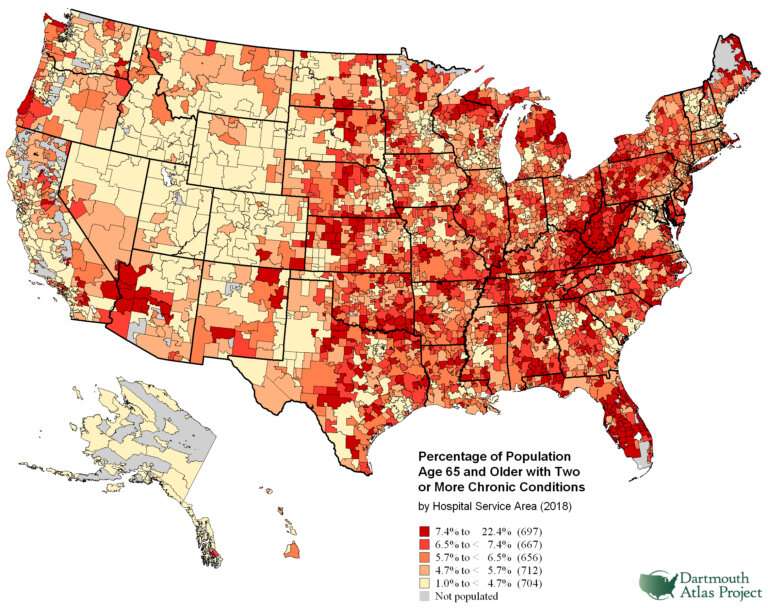Percentage of population age 65 and older with two or more chronic conditions. Credit: Dartmouth University
How widespread is the novel coronavirus in the U.S.? The answer depends on whose maps you consult. But a recent study by the Dartmouth Atlas Project, using data from the New York Times, paints a troubling picture.
"The findings are clear. No region of the country has escaped the virus. As of April 20, every region has at least 20 cases, and the vast majority have over 100," says lead researcher Elliott Fisher, a professor of community and family medicine at The Dartmouth Institute for Health Policy and Clinical Practice (TDI) and the Geisel School of Medicine.
It's true that in some rural areas of the U.S., confirmed cases might appear to be few and far between. Aggregating data by county can present a falsely reassuring pattern, say the study authors.
To get a better handle on the geography of COVID-19 cases, Dartmouth Atlas divides the U.S. into hospital referral (HRR) regions, where patients where patients go for specialized care in addition to where they are admitted when they are hospitalized. Since HRRs include all rural areas of the country, the entire U.S. is represented in these regional analyses. Maps depicting the number of COVID-19 cases per 100,000, the average daily growth rate of COVID-19 cases in the last seven days, and the number of COVID-19 deaths per 100,000 show that the disease is affecting every region in which residents get hospital care.
In collaboration with Microsoft Healthcare NeXT and CareJourney, Dartmouth Atlas has also issued data about the regions in the U.S. with Medicare beneficiaries over the age of 65 who have two or more chronic conditions—the people most vulnerable to developing severe cases of COVID-19. Chronic diseases include diabetes, vascular disease, chronic kidney disease, heart disease, lung disease and cancer. The concentration of highest-risk people ranged from less than 2 percent to over 22 percent, with many living in Florida. (The team drew on data from 2018 Medicare claims data and the U.S. Census estimates of the age distribution of the U.S.)
"We hope that our work to identify regions in the U.S. with populations at greatest risk from COVID-19 will help public officials to contain this epidemic," says Jonathan Skinner, the James O. Freedman Presidential Professor in Economics and a co-author of both institute studies.
Even though they will be updating their maps, Dartmouth Atlas researchers say their approach cannot perfectly capture what's happening on the ground, every day, in every place. "Because the alignment of counties and hospital referral regions is imperfect, our reported case rates and growth rates are estimates," says Fisher. "But such regional data is essential as it can help reveal when it may be reasonable to begin to loosen physical distancing requirements. It will also be critical to identify the new outbreaks that will likely occur as we try to do so."
Provided by Dartmouth University
























